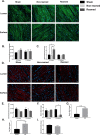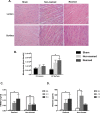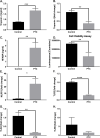Structural alterations and inflammation in the heart after multiple trauma followed by reamed versus non-reamed femoral nailing
- PMID: 32584885
- PMCID: PMC7316303
- DOI: 10.1371/journal.pone.0235220
Structural alterations and inflammation in the heart after multiple trauma followed by reamed versus non-reamed femoral nailing
Abstract
Background: Approximately 30,000 patients with blunt cardiac trauma are recorded each year in the United States. Blunt cardiac injuries after trauma are associated with a longer hospital stay and a poor overall outcome. Organ damage after trauma is linked to increased systemic release of pro-inflammatory cytokines and damage-associated molecular patterns. However, the interplay between polytrauma and local cardiac injury is unclear. Additionally, the impact of surgical intervention on this process is currently unknown. This study aimed to determine local cardiac immunological and structural alterations after multiple trauma. Furthermore, the impact of the chosen fracture stabilization strategy (reamed versus non-reamed femoral nailing) on cardiac alterations was studied.
Experimental approach: 15 male pigs were either exposed to multiple trauma (blunt chest trauma, laparotomy, liver laceration, femur fracture and haemorrhagic shock) or sham conditions. Blood samples as well as cardiac tissue were analysed 4 h and 6 h after trauma. Additionally, murine HL-1 cells were exposed to a defined polytrauma-cocktail, mimicking the pro-inflammatory conditions after multiple trauma in vitro.
Results: After multiple trauma, cardiac structural changes were observed in the left ventricle. More specifically, alterations in the alpha-actinin and desmin protein expression were found. Cardiac structural alterations were accompanied by enhanced local nitrosative stress, increased local inflammation and elevated systemic levels of the high-mobility group box 1 protein. Furthermore, cardiac alterations were observed predominantly in pigs that were treated by non-reamed intramedullary reaming. The polytrauma-cocktail impaired the viability of HL-1 cells in vitro, which was accompanied by a release of troponin I and HFABP.
Discussion: Multiple trauma induced cardiac structural alterations in vivo, which might contribute to the development of early myocardial damage (EMD). This study also revealed that reamed femoral nailing (reamed) is associated with more prominent immunological cardiac alterations compared to nailing without reaming (non-reamed). This suggests that the choice of the initial fracture treatment strategy might be crucial for the overall outcome as well as for any post-traumatic cardiac consequences.
Conflict of interest statement
the authors have declared that no competing interests exist.
Figures






Similar articles
-
Cardiac Depression in Pigs after Multiple Trauma - Characterization of Posttraumatic Structural and Functional Alterations.Sci Rep. 2017 Dec 19;7(1):17861. doi: 10.1038/s41598-017-18088-1. Sci Rep. 2017. PMID: 29259232 Free PMC article.
-
Reaming of femoral fractures with different reaming irrigator aspirator systems shows distinct effects on cardiac function after experimental polytrauma.J Orthop Res. 2020 Dec;38(12):2608-2618. doi: 10.1002/jor.24830. Epub 2020 Sep 1. J Orthop Res. 2020. PMID: 32827323
-
Changes in the management of femoral shaft fractures in polytrauma patients: from early total care to damage control orthopedic surgery.J Trauma. 2002 Sep;53(3):452-61; discussion 461-2. doi: 10.1097/00005373-200209000-00010. J Trauma. 2002. PMID: 12352480
-
Intramedullary nailing of the femur: reamed versus nonreamed.J Am Acad Orthop Surg. 2000 Mar-Apr;8(2):83-90. doi: 10.5435/00124635-200003000-00002. J Am Acad Orthop Surg. 2000. PMID: 10799093 Review.
-
[The effect of bone marrow embolization on the choice of procedure in the stabilization of femoral fractures].Orthopade. 1995 Apr;24(2):151-63. Orthopade. 1995. PMID: 7753540 Review. German.
Cited by
-
Cardiac damage after polytrauma: the role of systematic transthoracic echocardiography - a pilot study.World J Emerg Surg. 2025 Mar 11;20(1):21. doi: 10.1186/s13017-025-00596-5. World J Emerg Surg. 2025. PMID: 40069898 Free PMC article.
-
Evaluation of New Cardiac Damage Biomarkers in Polytrauma: GDF-15, HFABP and uPAR for Predicting Patient Outcomes.J Clin Med. 2024 Feb 8;13(4):961. doi: 10.3390/jcm13040961. J Clin Med. 2024. PMID: 38398274 Free PMC article.
-
Exploratory Investigation of the Plasma Proteome Associated with the Endotheliopathy of Trauma.Int J Mol Sci. 2022 Jun 1;23(11):6213. doi: 10.3390/ijms23116213. Int J Mol Sci. 2022. PMID: 35682894 Free PMC article.
-
Emergency Medicine with Advanced Surgery Protocols: A Review.J Environ Public Health. 2022 Sep 26;2022:3513250. doi: 10.1155/2022/3513250. eCollection 2022. J Environ Public Health. 2022. Retraction in: J Environ Public Health. 2023 Aug 2;2023:9754602. doi: 10.1155/2023/9754602. PMID: 36200087 Free PMC article. Retracted. Review.
-
Polytrauma: update on basic science and clinical evidence.OTA Int. 2021 Feb 23;4(1):e116. doi: 10.1097/OI9.0000000000000116. eCollection 2021 Mar. OTA Int. 2021. PMID: 33937720 Free PMC article. Review.
References
-
- Elie MC. Blunt cardiac injury. Mt Sinai J Med. 2006;73(2):542–52. Epub 2006/03/29. . - PubMed
-
- Huber S, Biberthaler P, Delhey P, Trentzsch H, Winter H, van Griensven M, et al. Predictors of poor outcomes after significant chest trauma in multiply injured patients: a retrospective analysis from the German Trauma Registry (Trauma Register DGU (R)). Scand J Trauma Resusc Emerg Med. 2014;22:9 10.1186/1757-7241-22-9 WOS:000341322600001. - DOI - PMC - PubMed
Publication types
MeSH terms
Substances
LinkOut - more resources
Full Text Sources
Medical

